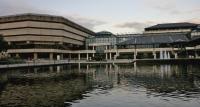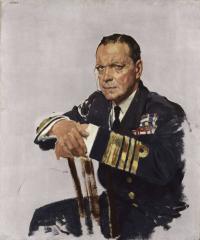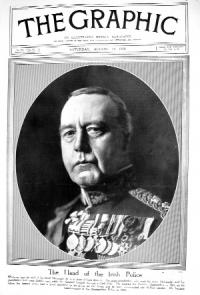Conflict in Ireland, 1916–1977: British cabinet papers on-line
Published in 20th-century / Contemporary History, Features, Issue 2(March/April 2012), Revolutionary Period 1912-23, Troubles in Northern Ireland, Volume 20
The UK National Archives at Kew, south London—an impressive facility housing a vast collection of material. (Mike Peel)
A visit to the UK National Archives at Kew is always a special trip for researchers examining manuscripts from the vast collection of material housed at the impressive south London facility. For students of conflict in Ireland, however, a new on-line facility allows researchers to download a wealth of material relating to Ireland from the British cabinet papers held at the National Archives for the periods 1913–23 and 1969–77, the two main phases of social and political upheaval in Ireland in the modern era. The cabinet papers (CAB) pertain to crucial military, legislative and political decisions and can be downloaded for free, without a reader’s ticket, for the very first time.The discursive framework of criminality and ‘outrage’ with which the Irish independence struggle was framed at the highest level in the British administration is the most revealing aspect of the papers, and the profoundly contemptuous tone of the rhetoric employed by key members of the military establishment is emblematic of a wider disdain for Irish nationalist political aspirations. Witness, for instance, ‘a report on the state of the people’ by First Sea Lord Rosslyn E. Wemyss, commander-in-chief, coast of Ireland, at the height of the conscription crisis in April 1918:

Sir William Orpen’s portrait of First Sea Lord Rosslyn E. Wemyss, commander-in-chief, coast of Ireland. At the height of the conscription crisis in April 1918 his ‘report on the state of the people’ epitomised the contemptuous tone and disdain for Irish nationalist aspirations of the British military establishment. (National Portrait Gallery, London)
The present situation is one of passive rebellion, everyone doing their work, while trying to get arms, ammunition, binoculars, etc., by force or by theft and damaging small unimportant property, which they think will embarrass authority and show their hatred for England. It may be truthfully said that nine Irishmen out of ten, south of the Sligo–Dublin line, cannot be trusted. They try to get employed in government works, such as dockyards, offices, etc., with a view to learning how to make bombs… If conscription be administered with a trembling hand, then the country will be in a flame, rebellion will be open and civil war will spread from Galway to Waterford. Should, however, the country be supplied with sufficient troops, firm and able and just generals be in command, and the conscription law be put firmly in hand, the rebels will offer trouble at first, there will be a vast amount of noise, a certain number of people will be shot, and then there will be a sullen acquiescence except for a certain number who will take to the mountains until starved out in the winter.’ (CAB 24/50)
As the independence struggle became mired in bloody conflict, reports by the last chief secretary for Ireland, Hamar Greenwood, left the cabinet in no doubt of the scale and nature of the rebellion, and in May 1921 he informed the cabinet:

General Neville Macready, GOC of the British Army in Ireland, stretched the limits of credibility by suggesting that the shooting dead of George Clancy and Michael O’Callaghan, the mayor and ex-mayor of Limerick, in March 1921 was the work of the local IRA rather than Crown forces. (The Graphic, 14 August 1920)
‘I regret to write that the crime statistics for the week are particularly bad. No less than 60 attacks on Crown forces were carried out during the week and the number of police and military casualties (55 including 23 deaths) is the highest on record for any week since the rebellion of 1916. Nearly one half of these occurred on 14th instant, the day following that of the elections for the Southern Parliament, and there appears to be no doubt that they were the outcome of a long pre-arranged plan to exhibit to the world the public demonstration of Sinn Féin’s political strength and it’s still unbroken power of maintaining an armed resistance to the authority of British law. To describe this murder outbreak as “warfare” is to do violence to language. In almost every case the act was one of deliberate cold-blooded assassin-ation…’ (CAB 24/123) The details of some of the most high-profile incidents of the War of Independence described in the papers are concocted fictions, however, reflecting the campaign of disinformation that military intelligence was employing to avoid responsibility for the killings of unarmed civilians. Accounts of some of the most well-known events, such as the shooting dead of George Clancy and Michael O’Callaghan, the mayor and ex-mayor of Limerick, in March 1921, stretch the absolute limits of credibility, with General Neville Macready suggesting that the killings were the work of Limerick republicans rather than Crown forces (CAB 24/121). Researchers familiar with RIC county inspectors’ monthly confidential reports will be familiar with this stock-in-trade explanation, which was repeatedly employed to describe killings carried out by the police and military. Elaborate fictions were reserved for high-profile cases, however, and, as these papers demonstrate, the vast majority of killings of ordinary people merely merited the standard explanation: ‘killed while resisting arrest’ or ‘killed while trying to escape’. In this respect, while these papers are an extremely important source, there is much that remains unexplained and it is unfortunate that they reveal nothing of the logic behind the shadowy process by which targets were singled out for assassination and by whose hands they were killed. The British Cabinet Papers can be downloaded on the UK National Archives website http://www.national archives.gov.uk. HI
Conor McNamara works at the University of Notre Dame’s Keough Naughton Institute for Irish Studies, Dublin.
















